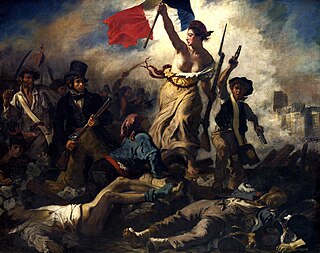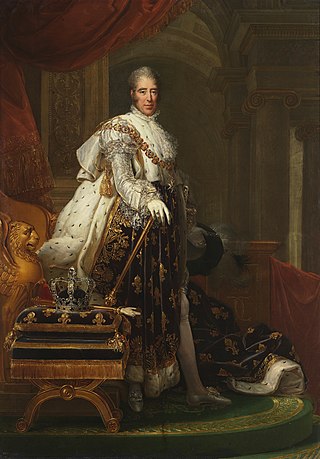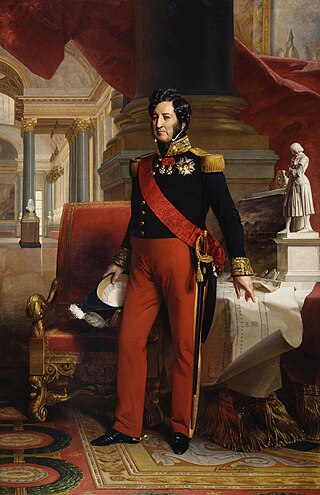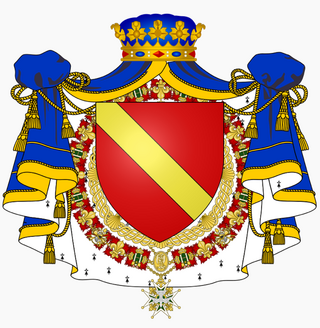Contents
| |||||
| Decades: | |||||
|---|---|---|---|---|---|
| See also: | Other events of 1830 History of France • Timeline • Years | ||||
Events from the year 1830 in France.
| |||||
| Decades: | |||||
|---|---|---|---|---|---|
| See also: | Other events of 1830 History of France • Timeline • Years | ||||
Events from the year 1830 in France.

1830 (MDCCCXXX) was a common year starting on Friday of the Gregorian calendar and a common year starting on Wednesday of the Julian calendar, the 1830th year of the Common Era (CE) and Anno Domini (AD) designations, the 830th year of the 2nd millennium, the 30th year of the 19th century, and the 1st year of the 1830s decade. As of the start of 1830, the Gregorian calendar was 12 days ahead of the Julian calendar, which remained in localized use until 1923.

The House of Bourbon is a dynasty that originated in the Kingdom of France as a branch of the Capetian dynasty, the royal House of France. Bourbon kings first ruled France and Navarre in the 16th century. A branch descended from the French Bourbons came to rule Spain in the 18th century and is the current Spanish royal family. Further branches, descended from the Spanish Bourbons, held thrones in Naples, Sicily, and Parma. Today, Spain and Luxembourg have monarchs of the House of Bourbon. The royal Bourbons originated in 1272, when Robert, the youngest son of King Louis IX of France, married the heiress of the lordship of Bourbon. The house continued for three centuries as a cadet branch, serving as nobles under the direct Capetian and Valois kings.

Charles X was King of France from 16 September 1824 until 2 August 1830. An uncle of the uncrowned Louis XVII and younger brother of reigning kings Louis XVI and Louis XVIII, he supported the latter in exile. After the Bourbon Restoration in 1814, Charles became the leader of the ultra-royalists, a radical monarchist faction within the French court that affirmed absolute monarchy by divine right and opposed the constitutional monarchy concessions towards liberals and the guarantees of civil liberties granted by the Charter of 1814. Charles gained influence within the French court after the assassination of his son Charles Ferdinand, Duke of Berry, in 1820 and succeeded his brother Louis XVIII in 1824.

Louis Philippe I, nicknamed the Citizen King, was King of the French from 1830 to 1848, the penultimate monarch of France, and the last French monarch to bear the title "King." He abdicated from his throne during the French Revolution of 1848, which led to the foundation of the French Second Republic.

Prince Ferdinand Philippe, Duke of Orléans was the eldest son of King Louis Philippe I of France and Maria Amalia of Naples and Sicily. He was born in exile in his mother's native Sicily while his parents were the Duke and Duchess of Orléans. Ferdinand Philippe was heir to the House of Orléans from birth. Following his father's succession as King of the French in 1830, he became the Prince Royal of France and Duke of Orléans. He died in 1842, never to succeed his father or see the collapse of the July Monarchy and subsequent exile of his family to the United Kingdom.

Henri, Count of Chambord and Duke of Bordeaux, was the Legitimist pretender to the throne of France as Henri V from 1844 until his death in 1883.

Orléanist was a 19th-century French political label originally used by those who supported a constitutional monarchy expressed by the House of Orléans. Due to the radical political changes that occurred during that century in France, three different phases of Orléanism can be identified:

Louis Philippe, comte de Ségur was a French diplomat and historian.

The Legitimists are royalists who adhere to the rights of dynastic succession to the French crown of the descendants of the eldest branch of the Bourbon dynasty, which was overthrown in the 1830 July Revolution. They reject the claim of the July Monarchy of 1830–1848 which placed Louis Philippe, Duke of Orléans, head of the Orléans cadet branch of the Bourbon dynasty, on the throne until he too was dethroned and driven with his family into exile.

The July Monarchy, officially the Kingdom of France, was a liberal constitutional monarchy in France under Louis Philippe I, starting on 26 July 1830, with the revolutionary victory after the July Revolution of 1830, and ending 23 February 1848, with the Revolution of 1848. It marks the end of the Bourbon Restoration (1814–1830). It began with the overthrow of the conservative government of Charles X, the last king of the main line House of Bourbon.

Victor de Broglie, 3rd Duke of Broglie, briefly Victor de Broglie, was a French peer, statesman, and diplomat. He was the third duke of Broglie and served as president of the Council during the July Monarchy, from August 1830 to November 1830 and from March 1835 to February 1836. Victor de Broglie was close to the liberal Doctrinaires who opposed the ultra-royalists and were absorbed, under Louis-Philippe's rule, by the Orléanists.

The title of Duke of Noailles was a French peerage created in 1663 for Anne de Noailles, Count of Ayen.

Louis Antoine of France, Duke of Angoulême was the elder son of Charles X and the last Dauphin of France from 1824 to 1830. He is identified by the Guinness World Records as the shortest-reigning monarch, reigning for less than 20 minutes during the July Revolution, but this is not backed up by historical evidence. He never reigned over the country, but after his father's death in 1836, he was the legitimist pretender as Louis XIX.
Events from the year 1875 in France.
The year 1848 in France, like other European countries, is mostly remembered as the year of a revolution that deposed king Louis Philippe and brought Napoleon III to power as president of the second republic.
Events from the year 1814 in France.

The June Rebellion, or the Paris Uprising of 1832, was an anti-monarchist insurrection of Parisian republicans on 5 and 6 June 1832.

Louis Antoine Philippe d'Orléans, Duke of Montpensier was a son of Louis Philippe, Duke of Orléans (1747–1793), and his duchess Louise Marie Adélaïde de Bourbon, Duchess of Orléans. He was the younger brother of Louis Philippe, later King of the French. Antoine had a deep affection for him, and they were only ever separated during the Reign of Terror and the events that followed between 1793 and 1797.

Philippe-Louis-Marc-Antoine, comte de Noailles, prince-duc de Poix, and 2nd Spanish and 1st French duc de Mouchy, was a French soldier, and politician of the Revolution.

Paris during the reign of King Louis-Philippe (1830–1848) was the city described in the novels of Honoré de Balzac and Victor Hugo. Its population increased from 785,000 in 1831 to 1,053,000 in 1848, as the city grew to the north and west, while the poorest neighborhoods in the center became even more crowded.